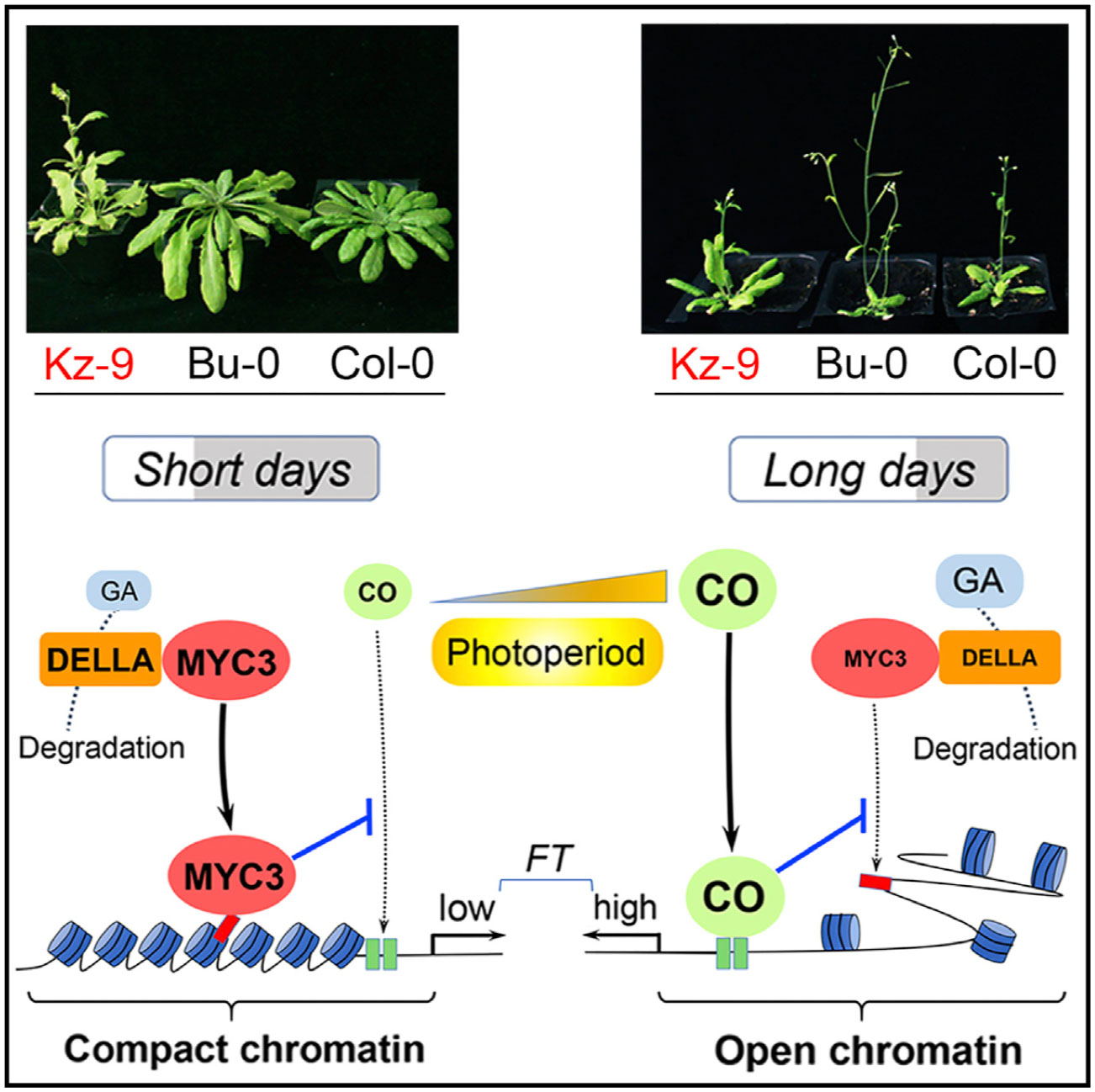博文
Developmental Cell:拟南芥光周期开花响应自然变异的遗传基础
||
Molecular Basis of Natural Variation in Photoperiodic Flowering Responses
First author: Shengjie Bao; Affiliations: National University of Singapore (新加坡国立大学): Singapore, Singapore
Corresponding author: Hao Yu
Plants exhibit different flowering behaviors in response to variable photoperiods across a wide geographical range. Here, we identify MYC3, a bHLH transcription factor, and its cis-element form the long-sought regulatory module responsible for cis-regulatory changes at the florigen gene FLOWERING LOCUS T (FT) that mediate natural variation in photoperiodic flowering responses in Arabidopsis. MYC3 is stabilized by DELLAs in the gibberellin pathway to suppress FT through binding the ACGGAT motif and antagonizing CONSTANS (CO) activation. Changing photoperiods modulate the relative abundance of MYC3 and CO, thus determining either of them as the predominant regulator for FT expression under different day lengths. Cis-regulatory changes in the MYC3 binding site at FT are associated with natural variation in day-length requirement for flowering in Arabidopsis accessions. Our findings reveal that environmental and developmental signals converge at MYC3 suppression of FT, an elementary event underlying natural variation in photoperiodic flowering responses.

不同地理分布区域具有不同的光周期,因而导致植物的开花行为也不尽相同。本文中,作者鉴定了一个bHLH转录因子MYC3及其顺式作用元件形成一个作用于开花基因FT的顺式调控模块,而FT基因则是拟南芥光周期开花响应变异的主要原因。DELLA通过赤霉酸途径稳定MYC3蛋白,而MYC3蛋白通过结合ACGGAT基序和拮抗CO的激活抑制FT基因的表达。光周期的变化会调节MYC3和CO的相对富集程度,从而根据日长条件决定二者其一在FT基因的表达调控方面起到主要作用。FT基因的MYC3结合位点上的顺式调控的改变与不同拟南芥材料开花所需日长的自然变异相关。本文的发现揭示了自然和发育上的信号最后集中体现于MYC3抑制FT基因的调控,从而作用于不同拟南芥材料光周期开花响应的自然变异。
通讯:Hao Yu (http://www.tll.org.sg/group-leaders/hao-yu/)
个人简介:1994年,上海交通大学,学士;1997年,上海交通大学,硕士;2001年,新加坡国立大学,博士。
研究方向:拟南芥的成花转变;拟南芥的花分生组织发育。
doi: https://doi.org/10.1016/j.devcel.2019.05.018
Journal: Developmental Cell
Published date: June 06, 2019

https://blog.sciencenet.cn/blog-3158122-1185651.html
上一篇:Plant Biotechnol J:山金柑基因组测序与CRISPR系统建立
下一篇:Nature Plants:古葡萄基因组测序揭示法国葡萄多样性起源
全部作者的其他最新博文
- • Plant Physiology:CsMADS3促进柑果中的叶绿素降解和类胡萝卜素合成(华中农业大学)
- • Molecular Plant:LBD11-ROS反馈调节作用于拟南芥的维管形成层增殖和次生生长(浦项科技大学)
- • Science Advances:根结线虫通过调控植物的CLE3-CLV1模块,促进侵染进程(日本熊本大学)
- • Nature Communications:油菜素内酯参与植物营养生长期转变的分子机制解析(浙江农林大学)
- • Current Biology:光合作用产生的蔗糖驱动侧根“生物钟”(德国弗莱堡大学)
- • PNAS:花同源异型基因在叶中被抑制、花中被激活的分子机制(南卡罗来纳大学)